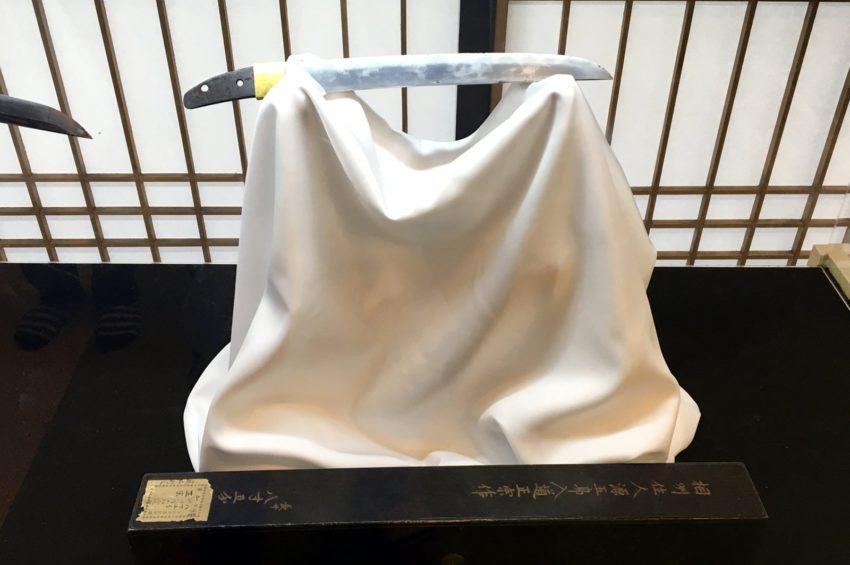The Japanese wakizashi sword, while less well-known than the popular Japanese katana, can be considered the true companion of the samuraiSAMURAI 侍 "warrior serving a lord" learn more... warrior. These short swords accompanied samurai wherever they went, and came to play an important role in the culture and traditions of Japanese swordsmanship.
The interesting history attached to wakizashi swords also makes them a great option for many sword collectors. Who knows what kind of tales might be hidden by these finely-made blades? Learn more about the wakizashi and you’ll see why having at least one of these gorgeous pieces in your collection is a must.
What is a Japanese Wakizashi Sword?
WakizashiWAKIZASHI 脇差 or 脇指 "medium-length sword" learn more... literally translates to “side-inserted sword.” This type of blade was most often worn as a companion to the more famous katanaKATANA 刀 "sword" learn more... of the samurai. The average length of a wakizashi was traditionally anywhere from 12 inches and 24 inches; much later in their use blade lengths were heavily regulated.
While nowadays you can find these short Japanese swords alone, during the time of the samurai they were usually worn together with a katana. Wearing a katana and a wakizashi together was an indication to others that the person was a samurai warrior. A matched pair of katana and wakizashi together formed a daishoDAISHO 大小 "big and small" learn more..., meaning “big-little.”
Once sword use and length regulation became popular among Japanese rulers, it became easier to distinguish between a katana and a wakizashi using the old Japanese unit of measurement known as a shaku (about 14 inches). Swords between one and two shaku (from their sword guard to their tip) were usually classified as wakizashi. Those between two and three shaku were usually katana. These measurements are pretty reliable for original blades and high-class reproductions.
Variation in Wakizashi Design
Two Main Types of Wakizashi Sword
Wakizashi swords varied in one major aspect – their length. Ko-wakizashi had longer blades similar to the length of a katana. In comparison, o-wakizashi had shorter blades similar to another popular short sword, the tanto. While there definitely was also variation in styles and designs, these more often could be seen from one swordmaker to another.
Wakizashi were also generally created to match the katana of a samurai. This means that the stylistic differences among different swordmakers for katanas carried over to the shorter, companion swords.
History of the Japanese Wakizashi Sword
The use of the Japanese wakizashi sword dates back to the 15th and 16th centuries. Wakizashi were made using the same methods as katana, which means they were created with a large cutting surface and with durable steel. The longer blade of a katana, however, was not suited to fighting in close quarters, especially indoors. Wakizashi were the perfect short sword for indoor combat. Samurai began to favor the wakizashi over the older short sword known as the tantoTANTO 短刀 "short sword" learn more..., which was also used for indoor fighting.
Sword use was heavily regulated during the Edo Period in Japan, from around 1600 AD to 1870 AD, by the ruling Tokugawa Shogunate. Members of the privileged samurai warrior class were the only people permitted to carry long swords, such as katanas. Of course, this worked out well for the samurai, as you will see below. At this point in time, wakizashi also began to refer to the type of short sword described above. (Prior to the Edo period, wakizashi could literally be any kind of short sword worn together with another sword.)
The Purpose of the Wakizashi
Why exactly did samurai feel the need to carry more than one sword? It might be surprising given the durability and power of the katana, but the Japanese wakizashi sword was considered backup sword. The length of a katana blade made them very poor weapons for fighting in close quarters. Samurai carried wakizashi, which were shorter, but just as deadly, to defend themselves indoors or to finish off an injured enemy. Let’s just say it was easier to behead an opponent with a shorter blade during a fight. And kinder on a shorter blade when impeded by strong samurai armor.
Of course, wakizashi also had one more important use. These short blades would occasionally be called into service by their owners to help them commit ritual suicide, known as seppuku. In defeat, a samurai warrior would be granted one last act to maintain their dignity and honor: suicide by driving their short wakizashi swords straight into their gut. (The intestines were considered the place of a samurai’s power and honor.)
While katana might be stored away in a household to indicate good faith, many samurai slept with their wakizashi under their pillow. This was possible because wakizashi swords could be carried indoors. Katana, seen as the sole weapons of samurai warriors, were generally left in safekeeping outside of homes, castles, and official spaces.
Wakizashi, in this respect, could be compared to pistols. Everyone took them anywhere, because ancient Japan was a wild, wild world.
Other Short Swords: Wakizashi vs. Kodachi
The Japanese wakizashi sword is most often compared to another Japanese short sword called the kodachiKODACHI 小太刀 "small tachi sword" learn more.... Kodachi swords, however, were more often much longer than wakizashi swords. Kodachi were also mounted similar to tachi swords, whereas wakizashi were mounted like katanas. Because wakizashi swords were often much shorter, they were well within the length limits imposed on civilians during the Edo Period. Many civilians, especially merchants, carried wakizashi swords. They probably wouldn’t have been able to carry a kodachi sword.
Famous Japanese Wakizashi Swords
Like famous katana swords, there are instances of wakizashi swords that have passed into legend and cultural popularity. Here are a few examples of famous wakizashis that you may hear of.
Raikiri: “The Lightning Cutter”
This, perhaps the most famous wakizashi sword, was at first not a wakizashi sword at all. Bekki Dosetsu, who was the first head of the prominent Tachibana family, originally carried a tachi with the name Chidori (literally “A Thousand Birds.”) But a legend tells that Dosetsu was once struck by lightning while napping. Despite his poor health, he used a palanquin to fight in battle, with the use of his mighty sword. His sword was then reforged and renamed as Raikiri, meaning “lightning cutter.”
Dosetsu died without any surviving sons, but with one daughter, Tachibana Ginchiyo. Her father requested she be made head of the Tachibana family and for her to inherit his legendary sword, Raikiri. Famously, Ginchiyo recruited, trained, and led an elite group of women to protect her clan and home.
Appearance in Naruto
A sword with a story similar to that of Raikiri attached to it appears in the popular cartoon Naruto. The character Kakashi has a sword – known as Chidori – which becomes Raikiri after he uses it to cut a lightning bolt clean through. The ancient art of Japanese swordsmanship persists easily into today’s popular culture!
Why Should You Start Collecting Wakizashi Swords?
The Japanese wakizashi sword is a fun blade to collect, because of how ubiquitous they were at one point in Japan. Considering both samurai and merchants wore wakizashi swords wherever they went, authentic blades likely have interesting histories attached to them.
You should also note that these were the blades most often utilized for ritual suicide, which perhaps goes a long way to show how connected samurai warriors were to these swords. It also shows how vital to life and death these smaller, deadlier, and beautiful blades of the past have always been.

